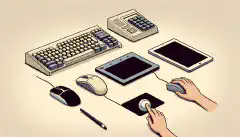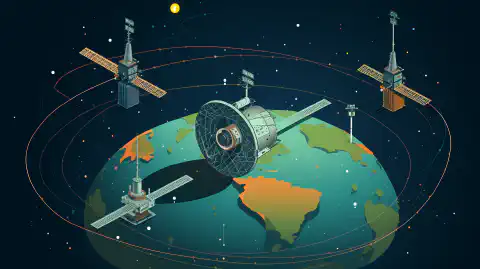Touch, Click, Swipe: Tracing the Journey of Input Devices

Table of Contents
The Evolution of Input Devices: From Keyboards to Touchscreens
The evolution of input devices has played a significant role in shaping the way we interact with computers and other electronic devices. From the early days of mechanical typewriters to the introduction of touchscreens and voice recognition technology, the way we input information has constantly evolved. In this article, we will explore the key milestones in the evolution of input devices and discuss their impact on our daily lives.
Key Takeaways
- The QWERTY keyboard layout, developed for mechanical typewriters, remains the standard input method for most computers today.
- The introduction of the mouse and trackpad revolutionized the way we navigate and interact with graphical user interfaces.
- Touchscreens have become increasingly popular, allowing for intuitive and direct interaction with devices.
- Voice recognition technology has made significant advancements, enabling hands-free control and natural language processing.
- Gesture control has emerged as a new way to interact with devices, offering a touchless and immersive experience.
The Evolution of Input Devices
From Mechanical Typewriters to QWERTY Keyboards
The transition from mechanical typewriters to QWERTY keyboards marked a significant milestone in the evolution of input devices. With the advent of typewriters, the process of writing and printing documents became more efficient and accessible. However, it also introduced new challenges in terms of speed and accuracy. The QWERTY keyboard layout, developed in the late 19th century, aimed to address these challenges by placing commonly used letters in a way that minimized the likelihood of mechanical jams. This layout has since become the standard for keyboards and has greatly influenced the design of modern input devices.
The Rise of Mouse and Trackpad
As a cybersecurity expert, I have witnessed the significant impact of the rise of mouse and trackpad in the evolution of input devices. These devices have revolutionized the way we interact with computers, providing a more intuitive and efficient means of navigation. The mouse, with its ability to move a cursor on the screen and click on objects, has become an essential tool for users to interact with graphical user interfaces. Similarly, trackpads have gained popularity in laptops, allowing users to navigate and control the cursor with their fingertips.
Touchscreens: A Revolution in Input Technology
Touchscreens: A Revolution in Input Technology
Touchscreens have revolutionized the way we interact with devices, providing a more intuitive and immersive experience. With the ability to directly manipulate objects on the screen, users can navigate through menus, scroll through content, and interact with applications with a simple touch. This technology has become increasingly popular in recent years, with touchscreens being integrated into smartphones, tablets, laptops, and even larger displays such as interactive whiteboards.
One of the key advantages of touchscreens is their versatility. They can support various input methods, including finger gestures, stylus input, and multi-touch gestures. This flexibility allows users to interact with devices in a way that feels natural and familiar. Additionally, touchscreens eliminate the need for external input devices such as mice or keyboards, simplifying the user interface and reducing clutter.
Another benefit of touchscreens is their potential for enhanced security. By incorporating biometric authentication methods such as fingerprint or facial recognition, touchscreens can provide an additional layer of security for accessing sensitive information. This is particularly important in the field of cybersecurity, where protecting data and preventing unauthorized access are paramount.
Despite their many advantages, touchscreens also have some limitations. One of the main challenges is the issue of accuracy. Unlike physical buttons or keys, touchscreens rely on virtual buttons and gestures, which can sometimes lead to accidental touches or misinterpretation of input. This can be especially problematic in situations where precision is crucial, such as when entering passwords or performing intricate tasks.
In conclusion, touchscreens have revolutionized the way we interact with devices, offering a more intuitive and immersive experience. They have become increasingly popular due to their versatility, simplicity, and potential for enhanced security. However, they also present challenges in terms of accuracy. As technology continues to evolve, it will be interesting to see how touchscreens further shape the future of input devices.
Voice Recognition: The Future of Input
Voice recognition technology has emerged as a promising advancement in the field of input devices. With the ability to convert spoken words into text, it offers a convenient and hands-free method of interacting with devices. This technology has gained significant attention in recent years, with major tech companies investing heavily in its development.
Gesture Control: A New Way to Interact
Gesture Control: A New Way to Interact
Gesture control is a cutting-edge technology that allows users to interact with devices using hand movements and gestures. It offers a unique and intuitive way of controlling devices, making it an exciting development in the field of input devices. With gesture control, users can perform actions such as swiping, pinching, and rotating without the need for physical buttons or touchscreens.
One of the key advantages of gesture control is its potential for enhancing cybersecurity. Traditional input devices like keyboards are vulnerable to keyloggers and other forms of malware that can capture sensitive information. With gesture control, the input is based on hand movements, which are much more difficult for hackers to intercept and decipher.
In addition to its cybersecurity benefits, gesture control also offers improved accessibility. People with physical disabilities or limited mobility can benefit from gesture-based input, as it eliminates the need for fine motor skills or physical contact with a device. This opens up new possibilities for individuals who may have previously struggled with traditional input methods.
Overall, gesture control represents a significant advancement in input technology. Its unique and intuitive nature, coupled with its potential for enhancing cybersecurity and accessibility, make it a promising option for the future of input devices.
The Evolution of Input Devices
The Evolution of Input Devices
In conclusion, the evolution of input devices has greatly transformed the way we interact with technology. From the early days of mechanical typewriters to the ubiquitous QWERTY keyboards, we have witnessed a gradual shift in the way we input information. The introduction of the mouse and trackpad revolutionized the way we navigate through graphical user interfaces, providing a more intuitive and precise method of interaction. However, it was the advent of touchscreens that truly revolutionized input technology, allowing for direct manipulation of digital content with our fingertips. As we look to the future, voice recognition technology holds great promise in enabling hands-free and natural input methods, while gesture control opens up new possibilities for intuitive and immersive interactions. The evolution of input devices continues to shape the way we interact with technology, and it will be fascinating to see what innovations lie ahead.
Frequently Asked Questions
What is the history of mechanical typewriters?
Mechanical typewriters were first invented in the late 19th century and became widely used for typing documents. They featured a set of keys that would strike inked ribbons onto paper, creating printed text.
When were QWERTY keyboards introduced?
QWERTY keyboards were introduced in the 1870s and became the standard layout for typewriters and later computer keyboards. The layout was designed to prevent the mechanical keys from jamming.
How did mouse and trackpad input devices become popular?
Mouse and trackpad input devices gained popularity with the rise of graphical user interfaces in the 1980s. They provided a more intuitive way to interact with computers, allowing users to point and click on icons and windows.
What is the significance of touchscreens in input technology?
Touchscreens revolutionized input technology by allowing direct interaction with the display. They eliminated the need for physical keyboards or mice, making devices more compact and portable.
What are the advantages of voice recognition as an input method?
Voice recognition allows for hands-free operation and can be a convenient input method for tasks such as dictation, virtual assistants, and controlling smart devices. It offers a more natural and efficient way of interacting with technology.
How does gesture control work as an input method?
Gesture control utilizes cameras or sensors to track and interpret hand movements, allowing users to interact with devices through gestures. It offers a touchless and intuitive way of controlling technology, particularly in virtual reality and gaming applications.





